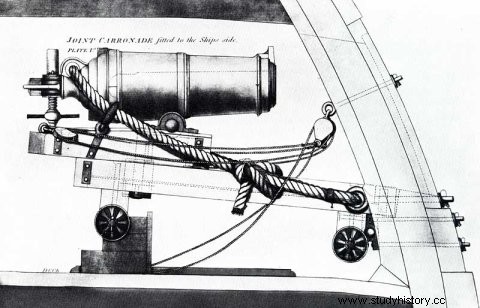Carronade
A carronade is a short piece of artillery developed by the Scottish Carron foundry from 1779. It was put into service on all Royal Navy ships three years after the trials on HMS Duke (98-gun 1st rank ship ). Carronades were not counted in the number of guns of a ship but could constitute the main armament of a frigate.
Through espionage and technical exchanges, France, which saw the effectiveness of this new rapid-fire weapon at its expense during the American Revolutionary War, conducted studies from 1786 (Perrier brothers , foundry of Chaillot) and develops its own models of carronade, from 1795.
Description

It included a very light chamber compared to the weight of the projectiles that it can be required to fire, which limits it to low-charge shots (1/9th the weight of its full cannonball), giving it a limited range (<300m) and thus allowing it to bring an old naval tactics:short-range combat followed by boarding (cf. Nelson's maneuver at Trafalgar, 1805), type of engagement which had disappeared following the adoption of the battle formation known as the "line of battle" .
This weapon fires solid cast iron cannonballs weighing from 18 to 68 pounds (depending on the caliber), hollow cannonballs or even grapeshot. The most common calibers in service with the fleet are 30, 24 and 18 pounds.
Due to the irregularity in the size of the cannonballs and the difficulty of boring the barrels of the guns, there was often a large gap between the ball and the metal of the cannon, the cannonball wind (often more than half a centimeter), resulting in a loss of efficiency. Eventually, the Carron company adopted new methods that allowed it to reduce this space.
Use
With a completely different shape and mounting compared to other guns, the main advantage of the carronade is that it leaves more free space between the batteries, is easier to maneuver, is lighter (a carronade of 36 lbs. as much as a 32 lbs. gun), to shoot faster and to employ fewer men for its service than the classic long gun but which, compared to the latter, is less precise, has more danger in the event of firing of incendiary projectiles and less chance of damage in its service. Still, the carronade remains a valuable weapon on light, small ships with small crews, as well as for forecastle batteries on larger ships.
The remarkable fact of this piece of artillery is the absence of recoil due to its fixed brague, which makes it quick to put into service with the elimination of the time of reactivation, as is the case on a classic piece. . Another advantage, and not the least, is that its fixed brague constitutes an axis around which the piece can pivot to be oriented in 360° shooting, a maneuver impossible to execute with a conventional gun, thus giving it a formidable efficiency during close combat of the type boarding, in particular to repel an assailant coming to gain a foothold on the forecastle where the piece is located.
This fixed brague is also its weak point since operating damage generally occurs on this part of the carronade, by the forces it supports during firing.
It also happened that the carronade was loaded with two types of projectiles at the same time:a normal cannonball, plus a box of grapeshot of a particular type, containing six to nine smaller cannonballs.
Decline
Too small a range in the face of opponents and above all the development by England of the technique of shielding by doubling the hull with copper (a technique initially designed from 1779 to protect the undercarriage of the ship from the proliferation of algae, hulls and shipworms, it is then generalized to the entire hull, prefiguring the shielding of the 19th century) mean that the carronade, less powerful than the traditional cannon, and therefore with less perforation power, naturally disappeared in the middle of the 19th century.
